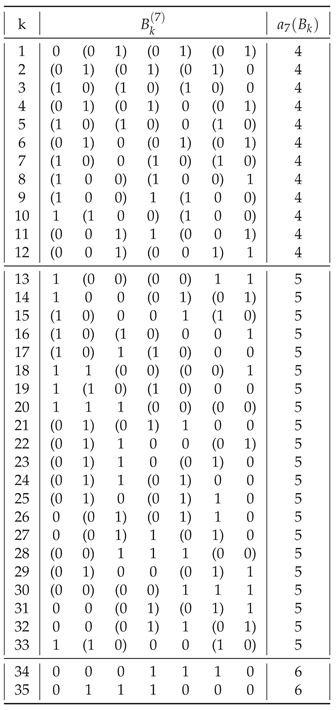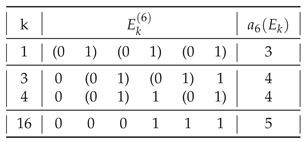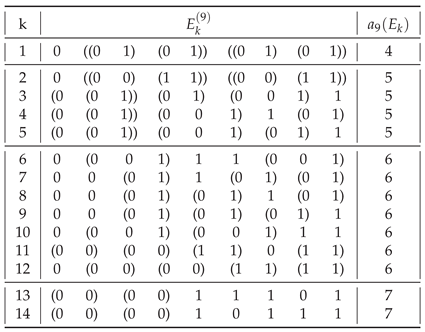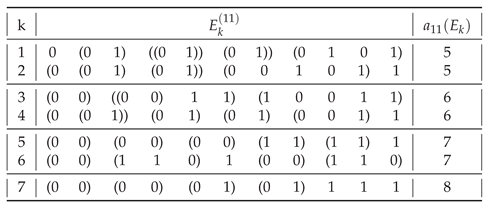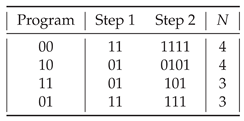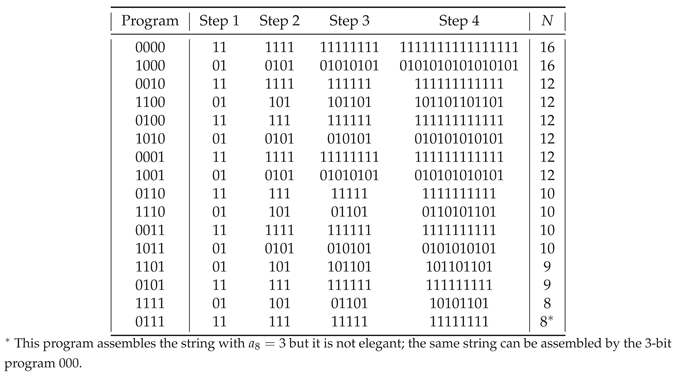2. Results
We consider binary strings
containing symbols
, which are our basis AT
objects [
2], with
zeros and
ones, having a fixed length
. We consider strings to be
messages transmitted through a communication channel between a source and a receiver, similarly to the Claude Shannon approach used in the derivation of information entropy [
28], and consider the process of their formation within the AT framework.
Definition 1. A string assembly index is the smallest number of steps s required to assemble a binary string of length N by joining two basic symbols contained in the initial assembly pool and strings joined in previous steps that are added to the assembly pool. Therefore, the assembly index is a function of the string .
For example, the 8-bit string
- 1.
join 0 with 0 to form , adding to P,
- 2.
join with 1 to form , adding to P,
- 3.
...
- 7.
join with 1 to form ,
join 0 with 0 to form , adding to P,
join with 1 to form , adding to P,
join with taken from P to form , adding to P,
join with 0 to form , adding to P,
join with 1 to form ,
join 0 with 1 to form , adding to P,
join with 0 to form , adding to P,
join with taken from P to form , adding to P,
join with taken from P to form .
Therefore, the string (
1) has an assembly index
that represents the length of the shortest assembly pathway leading to its assembly.
cannot be assembled in a simpler way.
Definition 2. A string is a balanced string if it has the same number of symbols, where or if N is odd.
Without loss of generality, we assume that if N is odd, (e.g., for , , and ). However, our results are equivalently applicable if we assume the opposite (i.e. a larger number of ones for an odd N).
The number
of balanced strings among all
strings is
1
This is OEIS A001405 sequence, the maximal number of subsets of an
N-set such that no one contains another, as asserted by Sperner’s theorem, and approximated using Stirling’s approximation for large
N.
BBs emit Hawking black-body radiation having a continuous spectrum that depends only on one factor, the BB temperature corresponding to the BB diameter , where and is the Planck length and temperature [8].
Triangulated BB surfaces contain a balanced number of Planck area triangles, each having binary potential , where c denotes speed of light in vacuum, as has been shown [8,10], based on the Bekenstein-Hawking entropy [29,30,31] . Here is the Boltzmann constant and is the information capacity of the BB surface, i.e., the Planck triangles corresponding to bits of information [8,9,10,30,32,33], and the fractional part triangle(s) having the area too small to carry a single bit of information [8,9].
Therefore, a balanced string represents a BB surface comprising active Planck triangles (APTs) with binary potential equal to [9].
|
Theorem 1. A string having length is the shortest string having more than one string assembly index 1.
Proof. The proof is trivial. For
the assembly index
, as all basis
objects have a pathway assembly index of 0 [
2] (they are not
assembled).
provides four available strings with
.
provides eight available strings with
. Only
provides 16 strings that include four stings with
and twelve strings with
including
balanced strings, as shown in
Table 1 and
Table 2.
For example, to assemble the string we need to assemble the string and reuse it. Therefore, for and for , where denotes a set of different assembly indices. □
Interestingly, Theorem 1 strengthens the meaning of as the minimum information capacity that provides a minimum thermodynamic (BH) entropy [29,30,31].
There is no disorder or uncertainty in an object that can be assembled in the same number of steps . |
In the following, we derive the tight lower bound of the set of different string assembly indices 1.
Theorem 2 (Tight lower bound on the string assembly index). The smallest string assembly index as a function of N is given by the OEIS sequence A014701.
Proof. Strings for which , can be formed by joining two basic symbols, adding the pair to the pool and joining the longest strings taken from the pool until N is reached. Furthermore, if , then and only four strings provide such a minimal assembly index , , , and .
Therefore, we can use the following procedure
In other words, we recursively calculate the remainder of a division of N by the largest and increment the assembly index with every step s, noting that only at the first step it was equal to the largest s.
This procedure reflects the assembly of the string but gives the same as the procedure (OEIS A014701)
for the number of steps s to reach 1 starting from N. □
Theorem 3. The length of an elegant binary program required to assemble a string featuring the smallest assembly index 2 is equal to its assembly index.
Proof. An elegant program is the shortest program that produces a given output [
34]. We assume that the assembly pool
P is an ordered set and we define
Command 0: Take the last element from P, join it with itself, and output.
and
Command 1: Take the last two elements from P, join them with each other, and output.
as the only two commands applicable to the initial assembly pool containing only two basic symbols.
Then the program "" having a length of N bits will assemble the string having the assembly . Similarly, the program "" will assemble the string having . The remaining two strings and with can be assembled with the same two programs by reordering the initial assembly pool.
Furthermore, the remaining programs will assemble some of the shorter strings with the assembly index . For example, for the remaining six 3-bit programs will produce shorter strings with : six out of ten strings and four out of eighteen strings (and no string ), in total, ten strings as both "001" and "010" produce .
However, for , some of these programs are no longer elegant. For example, both programs "000" and "0111" assemble the string having the assembly index , but only the former is elegant. □
The binary assembly programs are listed in
Table 3,
Table 4 and
Table 5 for one version of the assembly pool and for
.
We note in passing that Theorem 3 would be violated if we defined the command "0" e.g. as "take the last element from the assembly pool, join it with itself, join with what you have already assembled (say at "the right"), and output". Then the 2-bit program "00" would produce
with the assembly index
. However, such a one-step command would violate the assumptions of assembly theory, as it would perform two assembly steps in one program step. An elegant program to output the gigabyte binary string of all zeros would take a few bits of code and would have a low Kolmogorov complexity [
35]. However, such a string would be
outputted, not
assembled. Furthermore, the length of such a program that outputs the string
would be shorter than the length of the program that outputs the string
, while in AT, the lengths of these programs must be the same. Theorem 3 is about
binputation2 of binary strings.
Theorem 3 is related to Gödel’s incompleteness theorems and the halting problem.
N cases of the halting problem correspond only to
, not to
N bits of information [
36]. Therefore,
N-bit elegant programs assemble all four strings
with
(with two versions of the assembly pool). Furthermore, we can consider all strings assembled by our
N-bit assembly program as corresponding to provable theorems. Any formal axiomatic system only enables proving only true theorems [
37].There is a more fundamental path to incompleteness that involves complexity, rather than self-reference [
37].
In the following, we conjecture the form of the upper bound of the set of different string assembly indices 1.
In general, of all strings
having a given assembly index, shown in
Table 1,
Table A2,
Table A3,
Table A4,
Table A5,
Table A6,
Table A7,
Table A8 and
Table A9, most are those having
. The only exceptions are
for
(
) and for
(
),
for
(
) and for
(
), and
for
(
).
Introducing the definition 2 of a balanced string allows us to reduce the search space of possible strings with maximal assembly indices to balanced strings only. With the exception of , of all strings having a maximum assembly index, most are balanced.
We can further restrict the search space to distinct strings.
Definition 3. A string is a distinct string if a ring formed with this string by joining its beginning with its end is unique among the rings formed from the other distinct strings .
There are at least two and at most
N forms of a distinct string
that differ in the position of the starting symbol. For example for
balanced strings, shown in
Table 2, two augmented strings with
correspond to each other if we change the starting symbol
Similarly, four augmented strings with
correspond to each other
after a change in the position of the starting symbol. Thus, there are only two distinct strings for
The number of distinct strings among all strings is given by the OEIS sequence A000031. In general (for ), the number of distinct strings is much lower than the number of balanced strings.
As asserted by the no-hair theorem [38], BH is characterized only by three parameters: mass, electric charge, and angular momentum.
However, BHs are fundamentally uncharged and non-rotating, since the parameters of any conceivable BH, that is, charged (Reissner-Nordström), rotating (Kerr) and charged rotating (Kerr-Newman), can be arbitrarily altered, provided that the area of a BH surface does not decrease [39] using Penrose processes [40,41] to extract electrostatic and/or rotational energy of a BH [42].
Thus, a BH is defined by a single real number, and no Planck triangle is distinct on a BH surface. We can define neither a beginning nor an end of a balanced distinct string that represents a given BH. |
By neglecting the notion of the beginning and end of a string, we focus on its length and content. In Yoda’s language,
"complete, no matter where it begins. A message is".
The numbers of the balanced
, distinct
, and balanced distinct
3 strings are shown in
Table 6 and
Figure 1.
We note that, in general, the starting symbol is relevant for the assembly index. Thus, different forms of a distinct string may have different assembly indices. For example, for
balanced strings
and
, shown in
Table A12 have
. However, these strings are not distinct, since they correspond to each other and to the balanced strings
,
,
,
, and
with
. They all have the same triplet of adjoining ones.
Definition 4. The assembly index of a distinct string is the smallest assembly index among all forms of this string.
Thus, if different forms of a distinct string have different assembly indices, we assign the smallest assembly index to this string. In other words, we assume that the smallest number of steps
where
denotes a particular form of a distinct string
, is the string assembly index of this distinct string.
| If an object that can be represented by a distinct string (a BB in particular) can be assembled in fewer steps, this procedure will be preferred by nature. |
The distribution of the assembly indices of the balanced distinct strings
is shown in
Table 7.
If a string for which is constructed from repeating patterns, then a string for which must be the most patternless. The string assembly index must be bounded from above and must be a monotonically nondecreasing function of N that can increase at most by one between N and .
Identifying the shortest pathway is known to be computationally challenging [
3]. This problem has been proven to be at least as hard as NP-complete [
43]. However, certain heuristic rules apply in our binary case. For example,
for we cannot avoid two doublets (e.g. ) within a distinct string and thus ,
for we cannot avoid two pairs of doublets (e.g. and ) within a distinct string and thus ,
for we cannot avoid three pairs of doublets (e.g. , , and ) within a distinct string and thus ,
for we cannot avoid two pairs of doublets and one doublet three times (e.g. , , and , and thus ,
etc.
Conjecture 1.
The problem of determining the assembly index of a given binary stringis NP-complete [43], while the problem of creating the string so that it would have a predetermined maximum assembly index for this length of the string is NP-hard.
We found it much easier to determine an assembly index of a given binary string than to create a string so that it would have a maximum assembly index as a function of the length of the string. A proof of conjecture 1 would also be the proof of the following conjecture.
Every computable problem and every computable solution can be encoded as a finite binary string. Here, determining whether the assembly index of a given string has its known maximal value corresponds to checking the solution to a problem for correctness, whereas creating such a string corresponds to solving the problem. Thus, AT would solve the P versus NP problem in theoretical computer science. There is ample pragmatic justification for adding
as a new axiom [
36].
Table 8 shows the exemplary balanced strings
having maximal assembly indices that we created (cf. also
Appendix B). To determine the assembly index
of the string
we look for the longest patterns that appear at least twice within the string, and we look for the largest number of these patterns. Here, we find that each of the two triplets
and
appear twice in
and are based on the doublets
and
also appearing in
. Thus, we start with the assembly pool
made in four steps and join the elements of the pool in the following seven steps to arrive at
. On the other hand, another form of this balanced distinct string
has
.
Conjecture 3 (Tight upper bound on a string assembly index). With exceptions for small N the largest string assembly index of a binary string as a function of N is given by a sequence formed by strings for , where denotes increasing by one, and 0 denotes maintaining it at the same level, and .
However, at this moment, we cannot state if this conjecture applies to distinct or non-distinct strings. The assembly indices for
are unique, whereas the assembly indices for
were discussed above and are calculated in
Appendix C for balanced and balanced distinct strings.
The conjectured sequence is shown in
Figure 2 and
Figure 3 starting with
(we note in passing that
is a dimension of the void, the empty set
∅, or (-1)-simplex). Subsequent terms are given by
, which is periodic for
and flattens at
, and
,
,
.
This sequence can be generated using the following procedure
We note the similarity of this bound to the Aufbau rule
4, the Janet sequence (OEIS A167268) and the monotonically non-decreasing Shannon entropy of chemical elements, including observable ones [
23]. Perhaps the exceptions in the sequence 3 vanish as
N increases.
The bounds 2 and 3 are shown in
Table 6 and illustrated in
Figure 2 and
Figure 3. No binary string cannot be assembled in a smaller number of steps than given by the bound 2 On the other hand, some strings cannot be assembled in a smaller number of steps than given by an upper bound (which for large
N, as we suppose, has the form presented in Conjecture 3).
Conjecture 4. There is no binary program that has a length shorter than the length of the string featuring the largest assembly index that could assemble this string.
Partial Proof. In assembling the string featuring the assembly index (the largest complexity), we cannot rely solely on the last or two last strings in the assembly pool. Thus, we need to index the strings in the pool. However, we cannot predict in advance how many strings there will be in the assembly pool. Thus, we do not know how many bits will be needed to encode the indices. □
The Hamlet tragedy contains approximately 130,000 letters. Assigning five bits per letter (32 possibilities), the Hamlet tragedy can be encoded in a string having
bits (81.25 kB) yielding the total number of possible strings
(including
), and their assembly indices are bounded by
The lower bound (
8) can be calculated directly using the procedures of Theorem 2. The upper bound (
8) can be estimated by finding the smallest
k that satisfies
and using the relation
of Conjecture 3.
We assume that the assembly index of the string encoding the actual Hamlet tragedy is close to the upper bound. Even if the probability of random typing of the Hamlet tragedy is unfathomably small, when constrained to the bounds of the physical universe [
5], as asserted by the infinite monkey theorem, this tragedy was once created by William Shakespeare.
SARS-CoV-2 genome sequence contains 29903 bases
. Assigning two bits per base it can be encoded in a string of
bits having the assembly index bounded by
3. Additional results
The [perceivable] universe is not big enough to contain the future; it is deterministic going back in time and non-deterministic going forward in time [
44]. But we know [
2,
8,
9,
10,
11,
12,
13,
14,
15,
16,
17,
18,
19] that it has evolved to the present since the Big Bang.
For
K subunits of an
object O the assembly index of AT is bounded [
1] from below by
and from above by
where in the latter case, the subunits must be distinct so that they could not be reused from the pool, decreasing the index. The lower bound (
11) represents the fact that the simplest way to increase the size of an
object in a pathway is to take the largest
object so far and join it to itself [
1]. However,
for
and
.
Perceivable information about any
object can be encoded by a binary string [
26,
27]. This does not imply that a binary string defines an
object. Information that defines a chemical compound, a virus, a computer program, etc. can be encoded by a binary string. However, a dissipative structure [
12] such as a living biological cell (or its conglomerate such as a human, for example) cannot be represented by a binary string (even if its genome can). This information can only be perceived (so this is not an
object defining information). Each of us is given to ourselves as a mystery [
45]. Therefore, since one bit is the smallest amount and the quantum of information, the lower bound 2 and the upper bound of the string assembly index define the allowed region of the assembly indices for binary strings.
The bounds 2, 3, (
11), and (
12) on the assembly index are shown also in
Figure 4 (adopted from [
1] and modified). According to the authors of [
1], the "green portion of the figure is illustrative of the location in the complexity space where life might reasonably be found. Regions below can be thought of as being potentially naturally occurring, and regions above being so complex that even living systems might have been unlikely to create them. This is because they represent structures with limited internal structure and symmetries, which would require vast amounts of effort to faithfully reproduce." [
1].
We disagree with this statement. It is obvious that a binary string itself is neither dissipative nor creative. It is its assembly process that can be dissipative or creative. Evolution is about assembling new information and optimizing it until it reaches its assembly index.
That is why, we found determining the assembly index of a given binary string
is easier than creating a string with a maximum assembly index for this length of the string (Conjecture 1). Once the new information is assembled (by a dissipative structure operating far from thermodynamic equilibrium, or created by humans) increasing the information entropy according to the 2
nd law of infodynamics [
16], it enters the realm of the 2
nd law of thermodynamics, and nature seeks how to optimize its assembly pathway decreasing information entropy. And only humans are gifted with creativity. Any creation is required to be shaped by the unique personality of the creator to such an extent that it is statistically one-time in nature [
46]; it is an imprint of the author’s personality.
The total entropy of the universe
S is constant and is the sum of the information entropy
and the physical entropy
. Therefore, over time [
19]
The time corresponds to an increasing information capacity. Bit by bit:
At first, the newly assembled information corresponds to the discovery by groping [
11]. However, its assembly pathway does not attain its most economical or efficient form all at once. For a certain period of time, its evolution gropes about within itself. The try-out follows the try-out, not being finally adopted. Then finally perfection comes within sight, and from that moment the rhythm of change slows down [
11]. The new information, having reached the limit of its potentialities, enters the phase of conquest. Stronger now than its less perfected neighbours, the new information multiplies and consolidates. When the assembly index is reached, new information attains its equilibrium (not necessarily a BH equilibrium) and its evolution terminates. It becomes stable.
There is a certain minimum amount of information
required to establish a creation, as shown in
Figure 4. Sixteen possibilities provided by the minimum of thermodynamic entropy [
29,
30,
31] bifurcate the assembly pathways (cf. Theorem 1) but none of these possibilities can be considered a
creation. However, the boundary between the green region of dissipative structures [
12] and the red region of human creativity remains to be discovered.
"Thanks to its characteristic additive power, living matter (unlike the matter of the physicists) finds itself ’ballasted’ with complications and instability. It falls, or rather rises, towards forms that are more and more improbable. Without orthogenesis life would only have spread; with it there is an ascent of life that is invincible." [
11]
BB having the energy given by mass-energy equivalence
where
,
denote the BB mass, and
,
denote the Planck energy and mass,
is the fine-structure constant and
is the
fine-structure constant related to
by
, and
k is the BB size-to-mass ratio (STM) [
10] (
if BB is BH).
It was shown [
9] based on the Mandelstam-Tamm [
47], Margolus–Levitin [
48], and Levitin-Toffoli [
49] theorems on the quantum orthogonalization interval that BBs generate (or rather
assemble) a pattern forming nonequilibrium shell (VS) through the solid-angle correspondence, as shown in
Figure 5. The BB entropic work
is the work done by all APTs of a BB. It is the product of the BB entropy [
29,
30,
31] and the general, complex BB temperature
which in modulus and for a BH (
) reduces [
10] to Hawking temperature
where
is the reduced Planck constant,
G is the gravitational constant, and
is the Planck temperature. In particular [
10]
where
is the energy equilibrium STM.
A VS has the information capacity bounded by
where
l is a VS defining factor. The number of APTs is bounded by
as shown in
Figure 6, and thus its binary potential
[
8,
9] is bounded by
and the theoretical probability
for a triangle on a VS to be an active Planck triangle is also bounded [
9] by
On the other hand, the entropy variation [
8,
50]
so that for
the lower bound (
24) is negative and the upper bound (
23) is positive (
in this range). The Planck triangle of VS is located
somewhere on the VS surface defined by a solid angle
that corresponds to the BB Planck triangle.
The BB information capacity is dictated by its diameter and the BB energy (
14) as a function of its diameter is the same for all BBs (it is independent on
k). However, the BB mass and density
are not.
Based on the orbiting condition
, where
is the orbital, and
the escape speed of an orbiting
object,
is the average distance from the center of the central
object to the center of the orbiting
object, and
is the mass of the central
object, the bounds
containing the velocity term
,
were also derived [
9]. Plugging
from the bounds (
21) into the bounds (
27) we arrive at
which is satisfied by real and imaginary (but not complex) velocities (for example, for
by
,
,
, and
). Taking the square root of the bounds (
28), using
,
[
9], and squaring again, we arrive at
The bounds (
28) and (
29), shown in
Figure 7, meet at
, where de Broglie and Compton wavelengths of mass
M are the same
where
p is the relativistic momentum. The same is the ratio of orbital to escape speed:
.
Furthermore, the bounds (
28) and (
29) do not overlap only for
. Therefore,
defines the dissipativity or the assembly range. Furthermore, the intersection of the bounds (
28) and (
29) is the common region for both velocities. If
is within this region, then
is as well. We note that the average orbital velocity of each orbiting
object only slightly exceeds its orbital speed
. This implies that the average VS defining factor
in (
21) for a VS orbiting
object (cf.
Appendix A).
BBs define a perfect thermodynamic equilibrium, and the bounds (
21) and (
22) show that nature uses optimally assembled information (cf. Conjecture 5) to assemble new information.
Figure 8 shows the bounds on the string assembly indices, and
Figure 9 shows the BB temperature (
17), energy (
14), and entropic work (
15) for
.
is a rational number for natural
.
Let us examine this process starting from the Big Bang during the Planck epoch and shortly thereafter, and for continuous (i.e., including fractional Planck triangle(s)).
There is nothing to talk about. It is a mystery.
The Big Bang has occurred, forming the 1
st BB. At
the BB temperature (
17) and subsequently at
the BH temperature (
17) become equal to the Planck temperature, but any BB in this range is still too small to carry a single bit of information and cannot be triangulated. However, independent BBs merge [
9,
10] summing their entropies and increasing the information capacity.
The first bit (a degree of freedom [
9]) becomes available, and the BH energy reaches the limit of the equipartition theorem for one bit (
). APTs on BBs begin to fluctuate. However, the bounds (
22) make them unable to generate any APTs on a VS (
).
This is the only range in which the lower AT bound (
11) is greater than the upper AT bound (
12).
The BH temperature (
17) exceeds its energy (
14) (
) [
9]. At
the BH energy (
14) is equal to the Landauer limit
[
51]. Shortly thereafter, at
, the BH density reaches the level of the Planck density For a BB [
10] Still
. Merging BBs expand fractional Planck triangle(s) to form the 2
nd bit.
The first nonvanishing
becomes available on a VS generated by a BB. The BH temperature (
17) is equal to its energy (
14) (
).
At
the BH entropic work (
15) is equal to the Landauer limit (
). At
the density of the least dense BB (
) drops below the modulus of its temperature.
.
With
BBs can finally be triangulated. Yet, containing only one APT (
), they are not ergodic [
9].
At
the BH surface gravity
drops below the Planck acceleration and the tangential acceleration [
8,
9] becomes real (
).
The BB assembly index bifurcates, minimal thermodynamic entropy [
30] is reached, and the relation (
22) provides the second bit on a VS (
). At this moment BB can be assembled in a different number of steps and nature seeks to minimize this number following the dynamics induced by the relation (
13). The BH temperature (
17) is equal to its entropic work (
15) (
).
The BH temperature (
17) finally drops below the entropic work (
15) limit and
.
A BB reaches the upper bound on distinct assembly index.
The imaginary Planck time appears at the BH surface [
8] heralding the end of the Planck epoch. After crossing this threshold, the VSs begin to operate with
on
, and the first dissipative structures can be assembled.
Nature enters a directed exploration phase (
) and selectivity emerges, limiting the discovery of new objects [
6].
A BB reaches the upper bound on nondistinct assembly index.
At
a first precise diameter relation can be established between the vertices of the BB surface. Furthermore, for
, the solid angle (
25) equals one steradian.
The onset of human creativity.
Figure 1.
Numbers of all strings (red), balanced strings (green), distinct strings (cyan), and balanced distinct strings (blue) as a function of the string length N.
Figure 1.
Numbers of all strings (red), balanced strings (green), distinct strings (cyan), and balanced distinct strings (blue) as a function of the string length N.
Figure 2.
Tight lower bound on the binary string assembly index 2 (red) and (red, dash-dot), conjectured upper bound on the binary string assembly index 3 (green), factual values of the string assembly index (blue) and the distinct string assembly index (cyan) and (green, dash-dot), for the string length .
Figure 2.
Tight lower bound on the binary string assembly index 2 (red) and (red, dash-dot), conjectured upper bound on the binary string assembly index 3 (green), factual values of the string assembly index (blue) and the distinct string assembly index (cyan) and (green, dash-dot), for the string length .
Figure 3.
Tight lower bound on the binary string assembly index (red) and (red, dash-dot), conjectured upper bound on the string assembly index (green) and (green, dash-dot), for the binary string length .
Figure 3.
Tight lower bound on the binary string assembly index (red) and (red, dash-dot), conjectured upper bound on the string assembly index (green) and (green, dash-dot), for the binary string length .
Figure 4.
An illustrative graph of complexity against information capacity: orange regions are impossible, as they are above or below the assembly bounds; yellow region contains structures optimally assembled (in equilibrium); green region contains dissipative structures; and red region is the region of human creativity (figure not to scale).
Figure 4.
An illustrative graph of complexity against information capacity: orange regions are impossible, as they are above or below the assembly bounds; yellow region contains structures optimally assembled (in equilibrium); green region contains dissipative structures; and red region is the region of human creativity (figure not to scale).
Figure 5.
A black body object as a generator of an entropy variation shell (VS) through the solid angle correspondence.
Figure 5.
A black body object as a generator of an entropy variation shell (VS) through the solid angle correspondence.
Figure 6.
Lower (red) and upper (green) bound on the number of APTs
on a VS as a function of the information capacity of the generating BB [
9].
Figure 6.
Lower (red) and upper (green) bound on the number of APTs
on a VS as a function of the information capacity of the generating BB [
9].
Figure 7.
Lower (red) and upper (green) bounds on and lower (blue) and upper (cyan) bounds on as a function of l defining VS. Characteristic velocities are , .
Figure 7.
Lower (red) and upper (green) bounds on and lower (blue) and upper (cyan) bounds on as a function of l defining VS. Characteristic velocities are , .
Figure 8.
Lower (red) and upper (green) bounds on the binary string assembly index of length and (blue), for .
Figure 8.
Lower (red) and upper (green) bounds on the binary string assembly index of length and (blue), for .
Figure 9.
Black body object energy (green); temperature (red), (red, dash-dot), (red, dash); and work (blue), (blue, dash-dot), (blue, dash),as a function of its information capacity in terms of Planck units, for .
Figure 9.
Black body object energy (green); temperature (red), (red, dash-dot), (red, dash); and work (blue), (blue, dash-dot), (blue, dash),as a function of its information capacity in terms of Planck units, for .
Table 1.
Distribution of the assembly indices for .
Table 1.
Distribution of the assembly indices for .
Table 2.
balanced strings .
Table 2.
balanced strings .
Table 3.
2-bit elegant programs producing strings with .
Table 3.
2-bit elegant programs producing strings with .
Table 4.
3-bit elegant programs assembling strings with .
Table 4.
3-bit elegant programs assembling strings with .
Table 5.
4-bit programs assembling strings with .
Table 5.
4-bit programs assembling strings with .
Table 6.
String length N, number of all strings , number of balanced strings , number of distinct strings , number of balanced distinct strings , and lower bound on the string assembly index.
Table 6.
String length N, number of all strings , number of balanced strings , number of distinct strings , number of balanced distinct strings , and lower bound on the string assembly index.
Table 7.
Distribution of assembly indices among balanced distinct strings for .
Table 7.
Distribution of assembly indices among balanced distinct strings for .
Table 8.
Exemplary balanced strings having a maximum assembly index. Conjectured () form of the maximum assembly index and its factual values for distinct () and non-distinct () strings (red if below the conjectured value, green - if above).
Table 8.
Exemplary balanced strings having a maximum assembly index. Conjectured () form of the maximum assembly index and its factual values for distinct () and non-distinct () strings (red if below the conjectured value, green - if above).

















